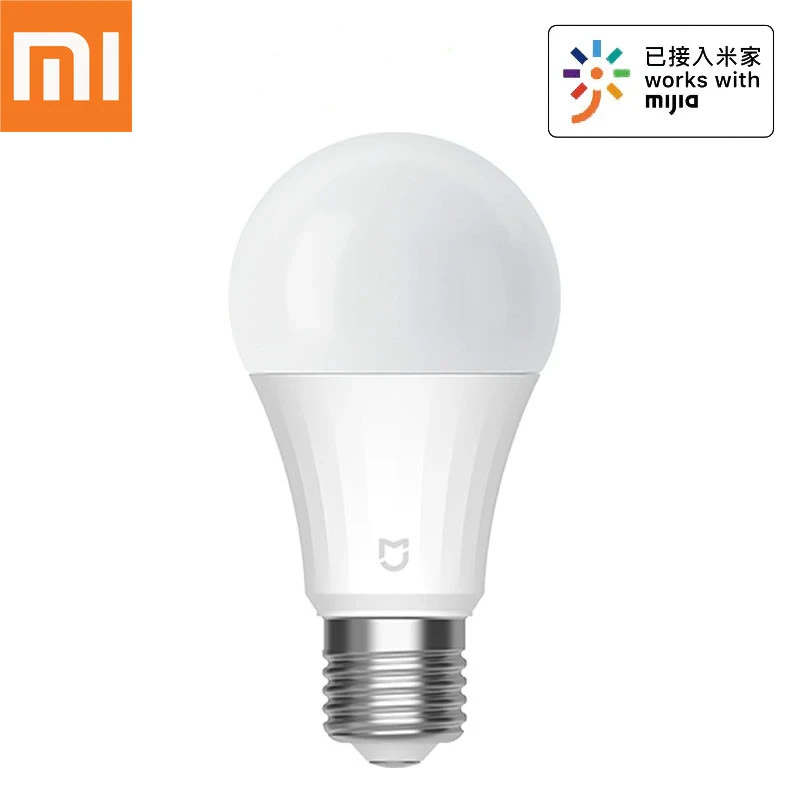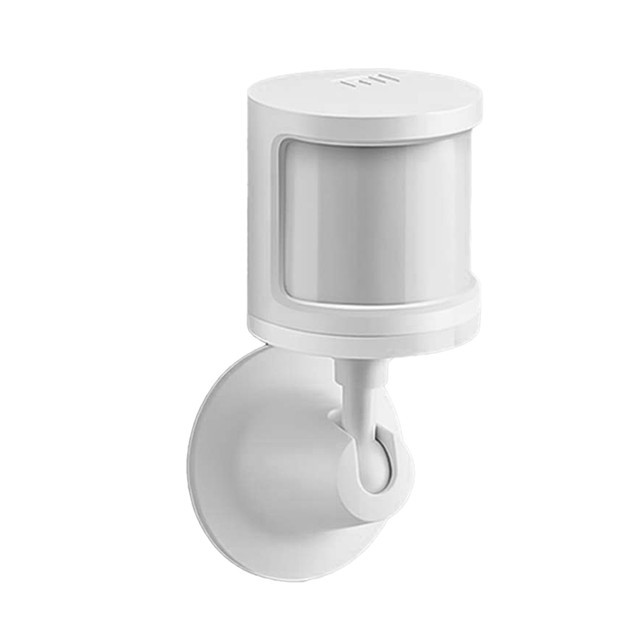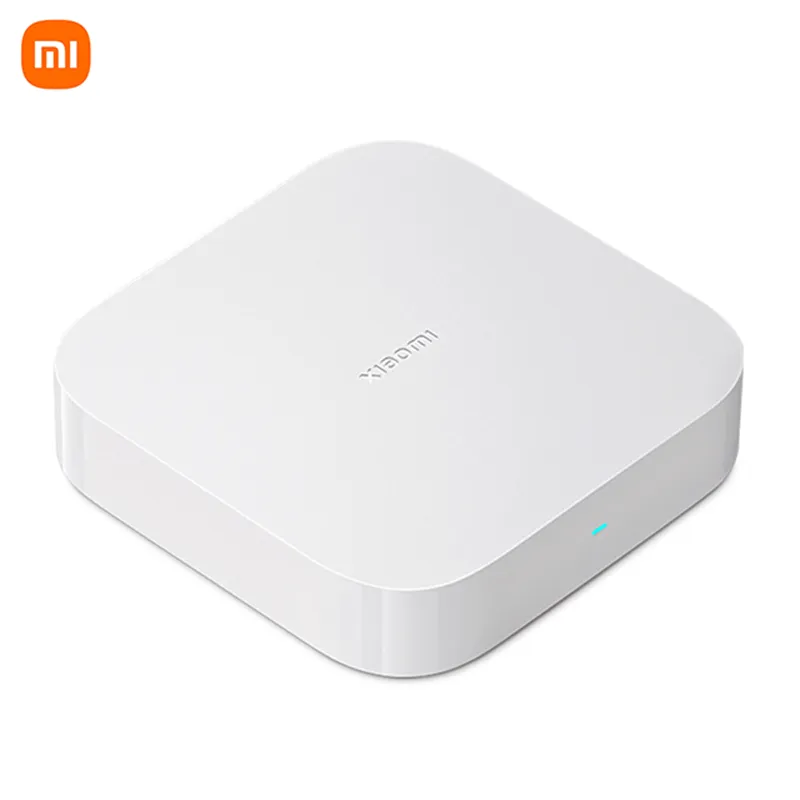 $8.60 - $22.71
$8.60 - $22.71Xiaomi Mi Motion Sensor 2 (Bluetooth Mesh Work With Mihome)
Xiaomi Mi Motion Sensor 2 - Human body sensor and ambient light detector, Mi Home compartible, works via Bluetooth Mesh
 $9.44 - $70.99
$9.44 - $70.99Xiaomi Mijia Smart Gateway 3 - Mi Home Hub, ZigBee, WiFi, Bluetooth Compatible
Xiaomi Mijia Smart Gateway 3 is a smart home hub that supports ZigBee, WiFi, and Bluetooth protocols, allowing you to connect and control all your smart devices through the Mi Home app.
 $12.50 - $12.50
$12.50 - $12.50Xiaomi Aqara Smart LED Light Bulb E27
Control your home lighting with Xiaomi Aqara Smart LED Light Bulb E27. It supports voice control via Amazon Alexa, Google Assistant and Apple HomeKit. Compatible with Mi Home, Aqara Home and other smart home platforms. Efficiently save energy by dimming the lights with the touch of a button.
 $9.44 - $70.99
$9.44 - $70.99Xiaomi Mijia Smart Gateway 3 - Mi Home Hub, ZigBee, WiFi, Bluetooth Compatible
Xiaomi Mijia Smart Gateway 3 is a smart home hub that supports ZigBee, WiFi, and Bluetooth protocols, allowing you to connect and control all your smart devices through the Mi Home app.
 $15.26 - $15.57
$15.26 - $15.57Aqara Smart Hub M1S: Wireless Zigbee 3.0 Gateway for Home Automation
Control and automate your smart home devices with the Aqara Smart Hub M1S. The gateway supports Zigbee 3.0 and WiFi connectivity, allowing you to connect and control a wide range of smart devices from Xiaomi Mijia, Homekit, and more. The built-in LED night light and remote control make it easy to operate the hub even in low light conditions.
 $119.00 - $123.67
$119.00 - $123.67Xiaomi Air Purifier 3 - Mi Air Cleaner - Ozone Remover - Smoke & Formaldehyde Filter - Smart Home Air Purifier - MiJIA App Control - Cube Shape
Keep your home fresh and clean with the Xiaomi Air Purifier 3. It effectively removes airborne particles, including PM2.5, formaldehyde, and tobacco smoke, while also reducing odors and sterilizing the air. The MiJIA App allows you to monitor and control the air purifier from anywhere, making it the perfect addition to your smart home. With its sleek cube design, the Xiaomi Air Purifier 3 will fit seamlessly into any room.
We hope you will find here a lot of useful information about Xiaomi Smart Home, like smart devices reviews, scenario hints for Mi Home app, and the best prices for Mi Home components.
How Smart home operating? In two words, for example, like this:
(Pictures above are leads to the components). Motion sensor detects movement, sends event to the gateway, and the gateway turns lamp on. In real life it can be much more complicated, but this example scenario also works.
There are a many manufactures, who producing smart devices compatible with Mi Home app: Mi, Mija, Aqara, Youpin and few others. But, on other hand, some new Aqara devices can work only with they own app and with Apple Homekit, so always check compatibility before order a new smart device.
What is the difference between a smart home and a regular home?
- A smart home
- is a home that is equipped with Internet of Things (IoT) devices and systems that can be controlled remotely or automatically. These devices can include smart thermostats, smart lighting systems, smart security systems, and other connected devices. A regular home, on the other hand, does not have these advanced features and relies on traditional heating, lighting, and security systems.
Popular categories
We always try to find the best prices for youA smart home allows you to solve almost any household tasks in your apartment, garden, or office. Smart home systems not only make our life more comfortable, but can also help to ensure security. For example, a smart home can include a video surveillance system with automatic notification of strangers (on your smartphone or in other ways) and automatic saving of video recordings on the server. Additionally, smart home can control of air cleanliness (carbon monoxide sensors, home gas leak sensors), water leak prevention (automatic shutdown of the water supply in case one of the wireless sensors detects a leak) and much more. In the Xiaomi smart home system, you can independently set your own work scenarios (which are called "scenes" in the "Mi-Home" application), which will allow you to fine-tune the operation of all systems in the smallest details, exactly as it is convenient for you (alas, their subtleties and some limitations Xiaomi still has them, but this can be considered a price to pay for ease of setup - otherwise you would have to learn a programming language to manage all the possible details of scripts, and ... inevitably make a lot of errors in your programs). Here are typical (but by no means all!) tasks that a smart home can solve:
- Climate control. Usually based on temperature and humidity sensors. Xiaomi also allows you to run scenarios depending on the "weather outside", but this is currently only implemented for China (you probably don't want to turn on the heater in London because it's getting colder in Beijing). Typical scenarios: "if the temperature in the room is below N degrees, turn on the heater." It can be a heater from Xiaomi, and then you will send a command directly to it, but much more often it will be a smart relay or a Xiaomi or Aqara smart socket, to which a regular household heater is connected. Similarly, when the humidity is too low, the humidifier can be turned on, and turned off when a certain higher value is reached. Among the huge variety of smart home devices, Xiaomi also has an IR remote control simulator. This means that if the temperature is too high, your Smart Home can turn on the air conditioner on its own. You can even put control mechanisms on all central heating radiators, and then you can change their temperature automatically (or from your smartphone) during the heating season.
- Light control. As a rule, light control is based on light sensors, motion sensors and wireless door sensors. It would seem - what's the problem, if you want automatic light control, just buy an inexpensive lamp that will turn on when it's too dark and motion is detected, and turn off after a while? It's very simple: not every such lamp will harmoniously fit into your home design, while Xiaomi will offer you seemingly ordinary light bulbs with an standard base, as well as spotlights for suspended ceilings. And if you want a dim light in the evening when you watch TV, and so that it does not turn off after a minute of no movement? So that the light in the toilet or bathroom turns off by itself as soon as you leave it? So that a completely subdued light lights up at night, soft yellow in the evening, and bright white during the day? If out of 10 spotlights on the kitchen ceiling you want only two to turn on above the dining table or above the stove? So that a long row of lamps on the ceiling in the hallway beautifully lights up and goes out one by one? To light up and go out smoothly? Or did you want to hang a wireless switch on the wall in a place where no wiring was provided? Any such wishes will be easily solved by your Smart Home.
- Security. Motion sensors and door sensors can send an alert to your smartphone if they are triggered and no one should be at home. The cameras will record and save video if motion is detected in security mode and give you an alert (they can distinguish a person from, for example, a pet, or a robot vacuum cleaner that does the cleaning in your absence and even in theory can recognize faces). So what? You found out in another city that there is someone in your house, what to do about it? First, you can call your neighbors or the police. And secondly, a very loud wireless siren (of course, it is also in the arsenal of Xiaomi smart home devices) can become an unpleasant surprise for an attacker. Not as reliable as private security, but free of charge (you may want to save detailed videos from surveillance cameras on the Xiaomi cloud server, in this case you can use a paid cloud). Home security is not just about securing your home. You can add to your system a carbon monoxide sensor, a domestic gas leakage sensor, a smoke sensor, a water leakage sensor, and implement various responses to their signals. For example, shutting off the water supply in the apartment when the water leak sensor triggers.
Of course, only a small part of the truly limitless possibilities of the "smart home" is described above. It is simply impossible to describe all the scenarios in one text. This system can take over the management of any issues in the house. Curtains can automatically open in the morning and close in the evening. The thermo-pot kettle can automatically turn on as soon as you wake up in the morning (for example - "turn on if the time is from 6 to 10 in the morning and movement is detected in the bathroom", and turn off late in the evening (by time, or if there is no movement for a long time). Video surveillance automatically turns on, and all the lights in the apartment will turn off when the front door is closed and there is no movement in any room for 10 minutes. A more complicated option: if the temperature on the hot water pipe (on the riser) fell close to room temperature, then turn off the hot water, open the boiler taps, and turn on the boiler. So you may not even notice that hot water was turned off in your house for prevention. Automatic watering of flowers, opening a window in a greenhouse, controlling blinds, controlling a robot vacuum cleaner, opening the front door lock using a fingerprint instead of a key - almost everything at home can be automated. Voice control is also available, including many devices which can work with voice assistant.
How does Smart Home work? Where to begin?
If you decide to opt for Xiaomi, for the full functioning of the "smart home" you will need to purchase main gateway (Mi home gatewayMi home gateway, Aqara gatewayAqara gateway, or other compartible), one or more, depending on the distances and the number of devices . For an one-two bedrooms apartment, as a rule, one such device is enough. The gateway is the "heart" of your "smart home". It connects with devices via the ZigBee wireless protocol or via bluetooth (BLE) and via WIFI - with the Xiaomi server. The gateway is essentially a small computer that in most cases is able to control smart home devices on its own, including when there is no Internet connection.
If you first want to see how such smart devices work in general, how to control them, you can start by purchasing a device that connects via WIFI. For example, it can be wonderful Philips LED bulbs, or an air purifierair purifier. Full-fledged work with devices connected via BLE or ZigBee is impossible without a gateway.
In any case, you will need to download and install the Mi Home application on your smartphone - your pocket remote control for all smart home devices. Registration in the Mi Home application should not raise questions, but there is one very important point: you have to specify the region correctly. It would seem logical to choose your home region. However, many Xiaomi devices can only be added to the app if the region "Mainland China" is selected. If you select China, then communication with the server may occur with small (up to 1-2 seconds) delays. If you choose your actual home region, then even if all the devices you have now work fine, you may have a device in the future that the application will not see. Yes, the region can be changed later. But this leads to a physical change of the server, and the loss of all already saved scripts. Their reconfiguration can take a lot of time.
After "Mi Home" the application has been installed and its registration finished, you can add the devices you have and start using them immediately. If you don't have a central gateway yet, you can set up some simple scenarios with Wi-Fi devices (you'll need an internet connection to manage them). In the case of a light bulb, you can turn it on/off, change its brightness, color, or set a schedule for when (and how) it will turn on and off. If you have an air purifier, you can set a notification on your smartphone when the degree of air pollution exceeds a certain value (you can also set a second notification for very high pollution - it will correspond to the appearance of smoke in the room). Also you can purchase a wifi relay or socket and turn on a heater or humidifier. But do not get too carried away with wifi devices at first, you can still make sure that working through a gateway using local network protocols is much more convenient.






